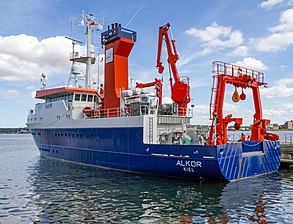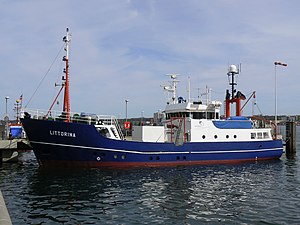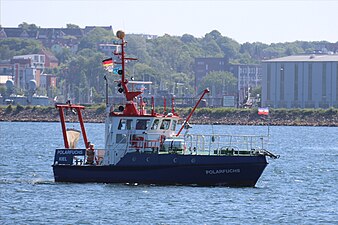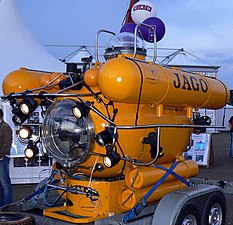GEOMAR Helmholtz Centre for Ocean Research Kiel
University of Kiel[3] | |
Budget | € 72 million[4] |
|---|---|
Staff | about 950 (scientists plus supporting staff) |
| Website | geomar.de |

GEOMAR Helmholtz-Zentrum für Ozeanforschung Kiel Ostufer
The GEOMAR - Helmholtz Centre for Ocean Research Kiel (GEOMAR), formerly known as the Leibniz Institute of Marine Sciences (
University of Kiel,[3] and operates the Kiel Aquarium[6] and the Lithothek, a repository for split sediment core samples.[7]
Research divisions
GEOMAR is structured into four research divisions:[8]
- Ocean circulation and climate dynamics: This division, led by Katja Matthes and Mojib Latif,[9] investigates climate from different time perspectives, with computer simulations and ocean current models that include meteorological, geological and oceanographic considerations. Current ocean measurements are made from research vessels at sea, and include the use of remote sensing.[10]
- Marine biogeochemistry: Work in this division looks at the way the components of the marine Field work is also undertakes, as well as laboratory and mesocosm studies. The division also develops biological, chemical and isotope diagnostic tools for measuring proxy variables.[11]
- Marine ecology: This division, led by Ulrich Sommer, aims to "understand the sensitivity of marine ecosystems to anthropogenic and natural changes, with a mid-term focus on climate change and overexploitation of marine bio-resources." It is important to understand how much stress a given ecosystem can absorb before structural shifts occur. When a shift does occur, it is necessary to understand how this will impact the ecosystem populations and the degree to which the shift can be reversed. Structural shifts can result in invasions by harmful organisms, species collapse and a radical reconfiguring of the biogeochemical cycles. Traditional approaches group species broadly into size classes and trophic levels measured by productivity or biomass. But to understand how ecosystems react to natural and anthropogenic stressors, specific differences in the way individual species react must also be understood, particularly where keystone species are involved. Research within this division range from genes to ecosystems, including the "ecophysiology of key species and its genetic basis, dynamics and genetics of individual populations and of communities, interactions within and among species, structure and response of entire food webs."[12]
- Dynamics of the ocean floor: Research is focused on "processes that shape the arc volcanism that creates and modifies the continental crust and transfers climate-relevant volatiles into the atmosphere. Such continental margins are sites of sediment accumulation, fluid exchange, important resources and major geo-hazards."[13]
Research fleet
GEOMAR operates two open ocean
AUV ABYSS,[23] and a video-controlled hydraulic grab, TV-Grab.[24] At the end of 2010, the institute took possession of ROV PHOCA, a new 1.5 ton ROV with an operational working depth of 3000 metres.[25]
-
Research vessel, RV Alkor
(1000GT) -
Research cutter, RC Littorina
(168 GT) -
Research boat, RB Polarfuchs
(16 GT) -
JAGO, a 3-ton manned research submersible
Notes
- ^ Consortium members Archived 2012-03-28 at the Wayback Machine Deutsches Forschungsbohrkonsortium. Retrieved 29 July 2011.
- ^ ISBN 978-0-521-13022-6.
- ^ University of Kiel. Retrieved 29 July 2011.
- ^ a b c d Leibniz Institute of Marine Sciences (IFM-GEOMAR) Archived 2012-03-27 at the Wayback Machine German Marine Research Consortium. Retrieved 28 July 2011.
- ^ Leibniz Institute of Marine Sciences (IFM-GEOMAR) Fisa, 21 July 2011.
- ^ Kiel Aquarium in the Institute of Marine Science Archived 2011-01-17 at the Wayback Machine Ostee-Radweg. Retrieved 29 July 2011.
- ^ Core Repositories Archived 2012-03-28 at the Wayback Machine Deutsches Forschungsbohrkonsortium. Retrieved 29 July 2011.
- ^ Organizational Structure of the Institute IFM-GEOMAR web site.Retrieved 20 July 2011.
- ^ GEOMAR: Ocean Circulation and Climate Dynamics
- ^ Research Division 1: Ocean Circulation and Climate Dynamics IFM-GEOMAR. Updated 5 August 2010. Retrieved 24 July 2011.
- ^ Research Division 2: Marine biogeochemistry IFM-GEOMAR. Updated 2 November 2010. Retrieved 24 July 2011.
- ^ Research Division 3: Marine Ecology IFM-GEOMAR. Updated 27 November 2009. Retrieved 24 July 2011.
- ^ Research Division 4: Dynamics of the ocean floor IFM-GEOMAR. Updated 16 September 2010. Retrieved 24 July 2011.
- ^ RV Poseidon Ocean Facilities Exchange Group. Retrieved 29 July 2011.
- ^ RV Alkor Ocean Facilities Exchange Group. Retrieved 29 July 2011.
- ^ Modernisation of the IFM-GEOMAR-research fleet Research in Germany. Retrieved 29 July 2011.
- ^ RC Littirina IFM-GEOMAR web site.Retrieved 20 July 2011.
- ^ RB Polarfuchs IFM-GEOMAR web site.Retrieved 20 July 2011.
- ^ Europe’s Big 3 Labs Sign New Oceanography Cooperation Pact Marine Science Today, 3 January 2009.
- ^ List of research submersibles by country Marine Technology Society. Retrieved 30 July 2011.
- ^ Kohnen, William (2005) Manned Research Submersibles: State of Technology 2004/2005 Marine Technology Society Journal, 39(3): 124.
- ^ Schilling Robotics’ Kiel 6000 ROV approved by GL Offshore Shipping Online, 9 January 2008.
- ^ AUV Abyss IFM-GEOMAR web site.Retrieved 20 July 2011.
- ^ V-Grab IFM-GEOMAR web site.Retrieved 20 July 2011.
- ^ New Remotely Operated Vehicle for IFM-GEOMAR Research in Germany, 17 January 2011.
External links
- GEOMAR Helmholtz Centre for Ocean Research Kiel Home page
- Organizational Structure GEOMAR Helmholtz Centre for Ocean Research Kiel
- OceanRep - Open access digital repository of GEOMAR Helmholtz Centre for Ocean Research Kiel research




